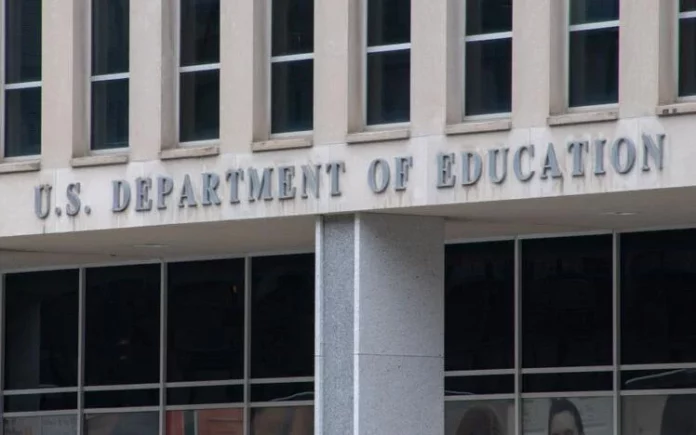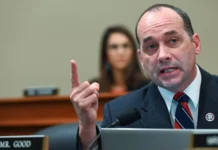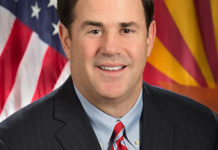Republican presidential candidates have put the U.S. Department of Education on notice.
Several candidates said at last week’s debate that they want to get rid of the U.S. Department of Education entirely.
Eliminating a Cabinet-level agency with 4,400 employees and a $90 billion proposed budget is a challenge that could take years to accomplish if any of the candidates could get the Congressional support needed to move forward with such a plan.
Getting the votes to dump the Department of Education would be a challenge on its own.
U.S. Rep. Thomas Massie, R-Ky., re-introduced a bill in February that would terminate the department on Dec. 31, 2023. Massie’s bill has 28 cosponsors. All of them are Republicans. To have a chance of becoming law with a Democrat-controlled Senate, any such measure would need bipartisan support.
Former President Ronald Reagan wanted to eliminate the Department of Education shortly after it took its modern form as a Cabinet agency in 1980. The Department of Education is primarily responsible for providing grants to public school districts and aid to college students.
Jonathan Butcher, the Will Skillman senior research fellow in education policy at The Heritage Foundation, said any serious effort to dismantle the Department of Education would require a thoughtful plan to phase it out.
“If we’re serious about this, and I think that we should be, it’s something that we’ll need a plan of phasing out the offices within the department that no longer serve a valid purpose and then moving other offices to different agencies within Washington,” he told The Center Square.
For example, Butcher said the Department of Education’s Office for Civil Rights could be moved to the U.S. Department of Justice, which has a Civil Rights Division. And the Department of Education’s National Center for Education Statistics could find a home within the U.S. Census Bureau, he said. Butcher said the federal government should also get out of the student loan business altogether.
“Washington should not be in the business of loaning money to students for college; it just shouldn’t,” Butcher said. “And what we have now is they monopolize the student loan market. They run some 90 plus percent of federal loans, and they have squeezed out the private sector.”
Butcher said Pell Grants and Stafford loans could be moved to the United States Department of the Treasury “and then the remainder would be eliminated.”
Butcher estimated it would take seven to 10 years to phase out the Department of Education.
Businessman and GOP candidate Vivek Ramaswamy didn’t get into details during the debate, but made it clear what he wants to do with the Department of Education.
“Let’s shut down the head of the snake, the Department of Education,” Ramaswamy said. “Take that $80 billion, put it in the hands of parents across this country.”
Former Vice President Mike Pence also said he’d shutter the Department of Education.
The Heritage Foundation laid out a more detailed plan in 2020. That plan estimated immediate savings of more than $17 billion and more over time.
“Savings over a decade would far exceed the immediate total, as a gradual phase-out of programs, such as Title I, is realized, restoring revenue responsibility to the states,” according to the report.
The Congressional Budget Office’s primer on eliminating Cabinet-level departments said savings from closing any such department would depend on multiple factors.
“Eliminating a department could result in considerable budgetary savings to the federal government if some or all of the programs operated by that department were also terminated,” according to the CBO. “The amount of savings would eventually be equal to the department’s full budget for the canceled programs, minus any income that the department had received through its operation of those programs. Initially, however, the government could incur one-time costs for terminating programs or activities, such as paying the cost of accrued annual leave and unemployment benefits to federal employees whose jobs had been eliminated or paying penalties for canceling leases for office space.”
The CBO also noted that many decisions would have to be made along the way to closure.
“In deciding whether to eliminate one or more of the current departments and whether to terminate, move, or reorganize its programs and activities, lawmakers would confront a variety of questions about the appropriate role of the federal government,” according to the CBO. “In particular, lawmakers would face decisions about whether the activities of a department should be carried out by the public sector at all, and if so, whether the federal government was the most effective level of government to conduct them. Even if lawmakers concluded that state and local governments were best positioned to operate a program or activity, they would still have to decide whether the federal government should coordinate particular activities that crossed state borders and whether programs administered by different states should meet national standards. In addition, lawmakers would face choices about how to organize most efficiently the activities of the federal government.”
The Department of Education was started in 1867, when President Andrew Johnson signed legislation creating the first Department of Education.
The National Education Association, the largest labor union in the nation, did not respond to a request for comment regarding the elimination of the Department of Education.
Republished with the permission of The Center Square.














